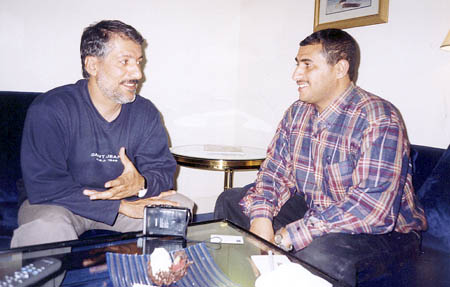An Escape From Reality [Archives:2001/19/Law & Diplomacy]
Abdul Bari Taher
In its issue No. 954 dated April 26, 2001, one of the headlines of the 26 September Newspaper read: “While The Search for a Background to Unify Curricula of the Ministry of Education and Those of the Scientific Institutes Continues, Advanced Steps to Unify Yemeni and Saudi Curricula Have Been Achieved.” This happy news includes that during the visit of Dr. Mohammed b. Ahmad Al-Rasheed, Saudi Minister of Education to Yemen an agreement with Yemen’s Ministry of Education was reached to unify textbooks including Chemistry, Physics, Biology, Maths and English. The paper added that the two sides exchanged curricula for more studies which will “lead to the removal of any mistaken piece of information about the other country and unify concepts about the common issues to ensure bringing up generations in an atmosphere of brotherhood, and neighborhood, love …” “On the other hand, the search is still on to unify the textbooks of the Ministry of Education and Scientific Institutes according to the General Educational Law,” it added.
According to this news, an agreement has been signed between Yemen and Saudi Arabia to unify their textbooks while the ‘search for a mechanism to unify the Yemeni textbooks is still going on.’ One wonders how our curricula are to be unified with those of the Saudi Arabia before being unified with those of the so-called Scientific Institutes in our country. And what is the relevance of the reference to the Public Educational Law?
The former Yemen Arab Republic (YAR) made use of the Scientific Institutes to oppose the curricula of the then People’s Democratic Republic of Yemen. During the period that followed the Unity Declaration, institutes with their curricula were used against the political, ideological and even military conflict with the Yemeni Socialist Party (YSP). Ironically, the General People’s Congress (GPC) convened a conferences to unify the two educational systems while the General Authority of Scientific Institutes continued to get its budget from the state. Moreover, when a law was issued to enforce the unity attempts of 1992, it was rejected by the President himself. Since then, the issue has been raised occasionally due to a conflict with the Yemeni Congregation for Reform (Islah) and the supporters and supervisors of those institutes. Despite the fact that the GPC has already added the scientific institutes’ budget to the general budget of the government educational institutes, the former still enjoys a relative independence and it has even increased in the same.
During two decades of their establishment, these institutes graduated thousands of people who are today holding good positions in educational fields. Is publicizing the agreement with the Saudi Ministry of Education a new tactic of the new Minister or is it a serious threat? Whatever the truth is, integrating the Yemeni and Saudi textbooks poses some questions.
The project is a further proof of the distinguished relations between the two countries and the sincere desire of their leadership to strengthen these relations. But we, Yemenis, know that more than 800,000 Yemeni laborers were forced out of Saudi Arabia during the Second Gulf War and the remaining Yemenis suffer rough and rude treatment. In addition, Yemen remains outside the GCC, despite the strong relations Saudi Arabia has with its Gulf neighbors. One should ask why Saudi Arabia is so generous in integrating its curricula with Yemen’s and it forbids Yemen from sharing in economic interests?
Going back to the main issue, what kind of research, books, etc., will each side take from the other? The latest event of border-demarcation teaches us, that we will be passive receivers, especially when we take into account the fact that we are talking about integration of curricula before national unity.
Yemen will integrate its text books with those of the Saudi Arabia before it solves the question of joining the GCC, in which it forms a part of the geography and regional community, and even before it restructures its own textbooks taught in schools and the so-called Scientific Institutes. What about the tribal conflicts between the leadership of Sana’a and Ryadh, a democratic system and a theocratic monarchic leadership? Will it be allowed in Saudi Arabia to teach Saudis the partisan and syndicalistic experiences? Or will Yemenis be forbidden from studying such old-fashioned idioms and terms? And will our children study about the Saudi citizenship, respect for judiciary as well as the infrastructure which Saudi Arabia has accomplished? The most serious question is: will Yemen build its institutions, achieve a national integration and impose the superiority of law and order before the expected unity?
Generally speaking, the issue is not that of a different and backward educational curricula, but rather an issue of escaping reality and the problems beforehand. I am not going to talk about how much Saudi Arabia spends on education because the matter is connected with huge resources that help cover cost of such services. However, since the 1980s, especially since the Gulf War and because of the sharp fall in oil price and the fabulous armament policies, education, just as many other services, started to decline. The situation is even worse in the case of Yemen where expenditure on the basic services can hardly be maintained if compared with that on the army and armament. Educational as well as health services in Yemen are just like the appendicitis. Since the 1970s, the Yemeni leadership tended to pollute education to serve its political interests and purposes. And it seems as if the government has become pathetic on the issue of education because their own children are sent to study in the best universities of America and Europe.
Many know that Arab Science and Cultural Organization prepared a united national curricula a few years ago. So why should we and the Saudis not make use of it if we are really sincere in our talks about brotherhood, its meanings and dimensions.
——
[archive-e:19-v:2001-y:2001-d:2001-05-07-p:./2001/iss19/l&d.htm]


